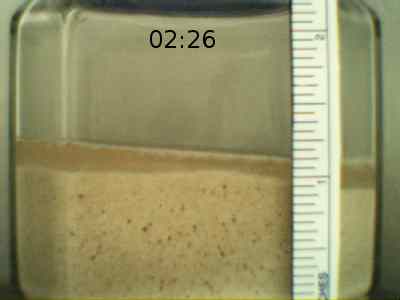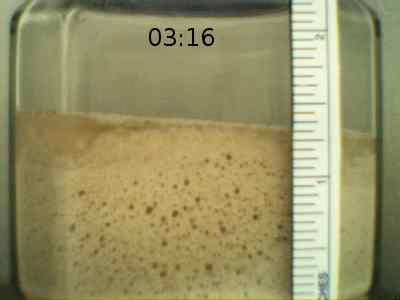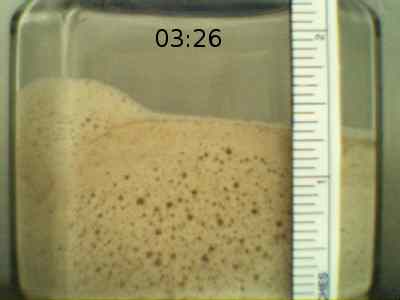by Curlydock
Nov 15, 2007
The diagram labeled “nov1002” displays a rudimentary test of my solar oven simulator. From this I hope to begin to see if the program is behaving correctly.
The oven cavity is seen as a ball above a triangular mirror.
A cross section of the solar flux is seen in yellow above right.
Any ray absorbed by the cavity is drawn in red. This could be either a ray directly from the sun or a ray reflected from the triangular mirror.
A ray reflected from the mirror that is not absorbed by the cavity is drawn as a short light blue vector. Any time a vector is drawn, the direction is indicated by the small ball at the end, which could be interpreted as an arrow head.
To reduce clutter in the diagram, the rays reflected and lost to space are drawn very short. They appear as a sort of light blue haze over the triangular reflector. You can see the “shadow” of the cavity on the mirror. Rays that neither hit the cavity nor the reflector are not drawn at all.
The program calculated the solar flux gain in this case to be 1.974359. This means that the cavity received almost twice as much solar radiation as it would have without any reflector at all. This is precisely what I would expect. The flux received by the cavity directly is doubled by the presence and proper placement of the mirror. The cavity would “see” two suns: one directly and the other reflected. Reciprocally, the sun would “see” two cavities, also one direct and one reflected. The analytical solar flux gain is two.
The theoretical flux gain without any reflector would be exactly one. That would be the minimum ever seen. Any properly directed reflections will increase that. The flux gain is calculated by dividing the quantity of rays absorbed with mirror concentrators in place by the quantity that would be absorbed directly from the sun when there are no mirrors. The simulation counts the rays and calculates the gain.
To see the importance of mirror orientation, we next consider what happens when the sun is at different angles, everything else remaining the same.
Diagram nov1003 shows how the flux gain drops to nearly unity when the sun is at a very low angle. The reason is that the triangular mirror is not of infinite extent. If it could be made large enough, we could get our gain back up to two. Thus the physical trade-off for the solar concentrator with the sun at small angles to the surface.
Diagram nov1004 shows the other extreme. Here, the sun is nearly at the zenith, but again the gain has dropped to nearly unity. This time the reason is that the cavity obscures the sun’s reflection. Where the cavity would “see” the sun it now only sees itself. The sun can only see the direct image of the cavity. The reflected image of the cavity is mostly hidden from the sun by the cavity itself.
These preliminary results continue to indicate that the simulation is correct.
Next, we can have the simulation sweep the solar altitude angle from zero degrees (on the horizon) to 90 degrees (at the zenith) and graph the flux gain against the solar angle. The triangular reflector is in the horizontal plane and therefore parallel with the horizon.
Diagram nov1005 shows the results of just such a sweep. We see the flux gain peaks at 2.0 broadly when the sun is around a 50.0 degree angle and falls to unity when the angle of the sun is either much more or much less than that.
In conclusion, the program I wrote to simulate some types of solar ovens seems to be working so far. I do still have reservations. There is more testing to do.
In future posts I hope to show the results of adding more reflecting flux concentrators. The flux gain will go up much more quickly with each added reflective plane as each added reflector exponentially increases the number of images (as in a kaleidoscope) while the increase in the number of mirrors is only linear. But limitations due to image obscuration, as we have already seen here, will subtract from the advantage of adding more reflectors, producing diminishing returns.
Some factors that affect real physics of multiple reflections I am going to ignore. I feel they would add a great deal of complexity without proportionally increasing the accuracy, at least for my purposes.
One of these factors is that every time a light beam is reflected, there is some loss. The amount of loss depends upon the angle of incidence. In my program, so far, this type of loss is not deliberately encoded. I assume no such losses.
Another factor is that no real reflector is perfect. Imperfect reflective surfaces will throw the light ray off at a non-ideal angle. Nor do I try to account for this effect.
Another factor is that I have some doubt about whether my program, as it is currently written, will ray-trace beyond about 4 or 5 reflections. I am not sure if this is true or why it happens if it does occur. I am keeping a look out for the effect but am not letting this doubt stop me from reaching for some results.
There may be other factors that have escaped my wildest dreams; who knows?
This work I put in the public domain for purposes of information and I do not claim it is perfect and suitable for just any application. If you are interested in seeing the listing, I am willing to share it. I can post it later.











